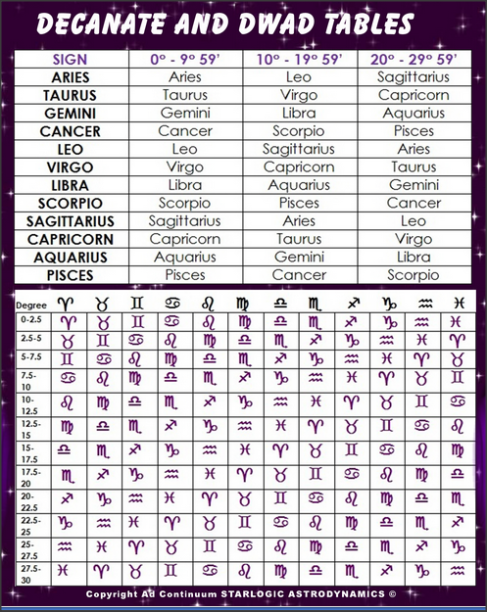Decans and duodenaries are the co-rulers and sub-rulers for each sign. Each sign is divided into three decans and twelve duodenaries, meaning there are a total of 36 decans and 144 duodenaries in the zodiac. The decan represents the co-ruler, and the duodenary the sub-ruler. It is necessary to highlight that the three decans of every sign are always of the same element as the sign it’s in. The sign a placement is in will account for the most diffuse influence of that placement. The decan denotes the specific co-influence in a placement. The duodenary, or duad for short, represents a more precise, sharper sub-influence. For the sake of simplification, the general guideline among most astrologers is that a placement receives 60% of its influence from the sign it’s in, 30% from the decan, and 10% from the duad.
Up until a week ago, I had only casually noticed the word decan in astrology, but didn’t bother looking into it, until recently. As for duads, I only learned about them just earlier today. Decans are popularly discussed among most modern astrologers, however, duodenaries are often dismissed by some modern tropical Western astrologers. The most probable reason some modern tropical Western astrologers neglect duads are likely because they add further complexity, thereby making astrology a dozen times more difficult to assess. Although, it’s critical to recognize that the system of duodenaries in astrology was regarded as a fundamental component by many ancient civilizations, including Mesopotamia, India, Kemet (Egypt), China, and Greece. All of the aforementioned ancient civilizations placed vital importance on the 144 duodenaries. So, why should we ignore them now?
My initial interest in decans and duads was prompted by a conversation I had with my lovely Piscean friend, Asia. We were discussing dominant signs in astrology. My most dominant signs according to the simple delineation chart by Walter Pullen are Capricorn, Scorpio, Pisces, and Aquarius (in that precise order). I brought up the fact that I feel like I am an atypical Scorpio, due to my soft, gentle nature. Unlike the archetypal Scorpio, I exhibit docile behavior and a pleasant demeanor. Asia suggested that this may be due to Capricornian influences in my natal chart, which is what prompted my curiosity that eventually lead down to reading up on decans and duads. Although, despite being a cardinal sign, Capricorn in astrology is described as a sign possessing a stern or cool exterior, which does not explain my warm aura and friendliness. My Capricornian influences are evident in the workplace and in my mature approach to social matters, but it ends there. After educating myself on decans and duads, I found out that my sun and Mercury are both in the second decan and seventh duad of Scorpio. The second decan of Scorpio is ruled by Jupiter and Neptune, rulers of Pisces. The seventh duad of Scorpio is ruled by Venus, ruler of Taurus. I’ve come to the realization that my fuzziness is coming from the Piscean influences of having a sun in the second decan of Scorpio, which is doubly magnified by my sun’s conjunction with Mercury. I also see the subtle Taurean influences of my seventh duad in Scorpio manifesting in my attachment to personal possessions as well as in my habits of gently touching friends and family members.
It is imperative to note that understanding decans and duodenaries aid in a more detailed interpretation of cusps. Now, the perception of cusps by modern astrologers vary greatly. Some modern astrologers believe that a cusp starts at 20° and ends at 9° 59′ 59′. Others will claim that a cusp starts at 26° 40′ and ends at 3° 19′ 59′. Many astrologers also discredit cusps altogether. Personally, my take on cusps is that they are legitimate. Though, I also have a more discriminating view on what qualifies as a cusp. I resonate mostly with the claim that a cusp is when a placement is at 29° to 1° of a sign, or in other words, <1° away from another sign (or house). In modern astrology, it is popularly said that a cusp will take on the positive and shadow traits of the sign, decan, and duad plus the positive traits of the sign and decan that the placement is bordering near, but not the shadow traits.
It is helpful if know your exact time and place of birth in order to calculate your decan and duad. Type birth chart calculator or natal chart calculator in your preferred web search engine and go from there. I personally recommend signing up for a free account on Astrodienst, my #1 favorite astrology website. Another excellent website is Astrotheme. You are able to calculate and save multiple birth profiles on both of the aforementioned sites.
Once you have calculated your natal chart with the exact place and time of birth, feel free to take a gander at the charts below to help you find your decan and duad. The first table lists the decans for each sign and the second table lists the duads for each sign.
Feel free to comment with the sign, decan, and duad of any placements you have, whether it’s planet(s), asteroid(s), midheaven, and/or ascendant. Also, have you noticed how your decans and/or duads affect any of your placement(s)? Let me know in the comment section below! 🙂

